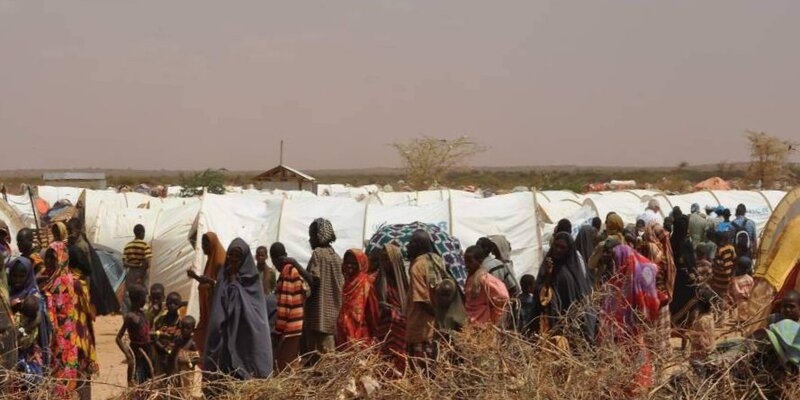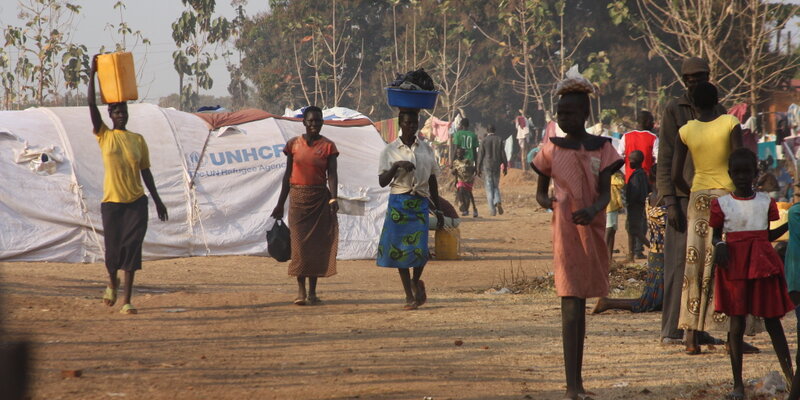Migrant worker. Photo: leniners/flickr, CC BY-NC 2.0
The relation between migration and health is a complex one and should not just be reduced to the health “of” migrants, but encompasses other aspects: migrant workforce is an important resource for our health system and migrants contribute greatly, through remittances, to the health of their own countries. (Ruggia 2016) However, when we wish to examine the health of migrants, the key explanatory concept that can be applied today is the one of the social determinants of health.
Social determinants of health (SDH) is a term used to describe the social and environmental conditions in which people are born, grow, live, work, and age, which shape and drive health outcomes. Factors that determine how the SDH conditions are experienced across societies include the distribution of power, money and resources. Unfair distribution creates avoidable health inequalities, known as ‘health inequities’. Therefore, social, economic, and environmental factors, as well as political and cultural factors, constitute the social determinants of health.

Migrant workers, Beijing. Photo: ILO Asia-Pacific/flickr, CC BY-NC-ND 2.0
Migration has not been always at the forefront of the SDH analysis. In the grounding document published by WHO in 2003, the word migration did not appeared once in the whole text. (Marmot and Wilkinson 2003) Since 2006, the International Organization for Migration (IOM) addressed the fact that migration is a social determinant of the health of migrants (Davies et al. 2006), but it is only following the 62nd World Health Assembly (2009) resolution Reducing Health Inequities through Action on the Social Determinants of Health, that the IOM fully recognizes the importance of addressing migration as a social determinant of the health of migrants.
It is only more recently that attempts have been made to better conceptualize the complex relations between migration, health and the socioeconomic factors (Thomas 2016) resulting usually in circular independent schemes.

Graphik: Thomas, Felicity (Ed.) (2016): Handbook of migration and health. Cheltenham, UK.
Usually the SDH and migration have been applied to understand some specific conditions, like infectious diseases, in particular HIV among migrants, or mental health. (Castañeda et al. 2015) It has been so far less the case for non-communicable diseases (NCD), this is why we choose to illustrate the case of SDH in migrants through the concrete example of diabetes.
Diabetes worldwide
Diabetes is one of the major NCD worldwide. According to WHO the number of people with diabetes worldwide has risen from 108 million in 1980 to 422 million in 2014, with a more rapid increase in Low and Middle-Income Countries (LMIC). The global prevalence has nearly doubled since 1980, from 4.7% to 8.5% in the adult population. This also reflects an increase in associated risk factors such as overweight or obesity. (World Health Organization 2016)
Type 2 diabetes has become a major global public health crisis, particularly in developing countries. The rise of diabetes is influenced by changes in lifestyle linked to rapid urbanization, nutrition transition, and increasingly sedentary lifestyles. This epidemic has grown in parallel with the worldwide rise in obesity. (Hu 2011) If there is no clear evidence that migrants have an increased prevalence of diabetes when they leave their country of origins, at least for the ones coming to Europe, migration appears to add to the risk of diabetes, as some studies point out. For instance, among African migrants to France, diabetes develops earlier compared to those that remain in their country of origin. (Choukem et al. 2014)

World Diabetes Day 2014 at PAHO. Photo: Pan American Health Organization PAHO/flickr, CC BY-NC 2.0
Diabetes prevalence in migrants
In migrant populations, generally, prevalence, incidence and mortality rates for diabetes are significantly higher than in native populations. (Montesi et al. 2016) In the UK prevalence among migrants of South Asian origin has been found to be around 20%, i.e. nearly 5 times higher than the local population, with age of onset occurring 5-10 years earlier than native population and with more common chronic complications. (Gholap et al. 2011) In the Netherlands, diabetes is more common by a factor of 2 among the main groups of immigrants (Turkey, Morocco, Suriname, Antilles). In the same study, diabetes mortality rates are even higher among migrants by a rate of 3 for men and 4 for women, which also indicates an important difference in gender distribution. (Stirbu et al. 2006) Higher mortality and gender differences were also confirmed in a European study covering seven countries and 30 migrants groups, finding a higher mortality, compared to native populations, of 90% among men and 120% among women. (Vandenheede et al. 2012) In Switzerland, there is a lack of relevant data for most-at-risk migrant populations.
SDH and the risks factors
When migrants arrive in a new country, they face many socio-economic challenges. In particular, because of their lower socio-economic status, they tend to have an alimentation of poorer quality, with more sugar, more fats and less fibre. In this nutrition transition, some foods might even be regarded by migrants as carrying a “positive” status symbol image, like sugary drinks or fast foods. When they come from very poor or deprived countries, parents might wish to indulge to their children wishes of sweets, thus increasing early obesity. Poor quality food is often abundant, cheaper and more accessible to migrants than high quality food thus contributing to create an obesogenic environment. In addition to those changes in alimentation behaviours, physical activity is definitely lower among migrants. (Dogra et al. 2010)
Problems in screening and treatment
Screening of diabetes might also be a problem. Are health structures promoting screening sufficiently? Evidence indicates that even when migrants participate in screening this is not a sufficient measure as they are not necessarily committed to taking action as a consequence of the screening. Strong cultural and religious beliefs can play an important role as an obstacle. (Andersson et al. 2016) In Switzerland, 30% of patients with type 2 diabetes remain undiagnosed. (Ammann and Fäh 2019) We can only suspect that this proportion is higher among some specific groups of migrants.
When in treatment for diabetes, migrants have a significant lower probability of adhering to guidelines or to be tested for HbA1c (glycated haemoglobin) measurement over time. (Ballotari et al. 2015; Seghieri et al. 2019) Social determinants plays also a role in the self-management of diabetes, but there is a significant lack of research in this respect regarding migrants.

Diabetes type 2 is largely preventable through diet and lifestyle modifications, but this needs adapted public health policies and planned interventions, especially among migrant populations. In Switzerland, it has already been demonstrated that preventive care among migrants is of significant lower quality compared to the one for the Swiss population. (Martin et al. 2014) Messages of prevention need to be repeated, contextualized and adapted to the specific migrant groups. Explaining the risk of diabetes once, during a medical consultation, might be largely insufficient to convince a migrant with a low level of health literacy to change her or his behaviour. There is a significant lack of public health campaigns targeted to migrants and this seems to be particularly true in the case of diabetes. Relevant campaigns should be promoted by using visual media in the languages of most at risk populations.
Consequences on public health policies
Evolution of migrations, whether in number or composition, will continue to play a fundamental role influencing diabetes developments in those populations. Those changes need to be taken constantly into consideration to adapt public health policies accordingly. In migrants, gender based differences, particularly negative for women, need to be addressed. More research is needed and a “cascade of care” (like the one used for HIV) approach, which has been explored, could be particularly suitable to identify gaps if applied to the relevant most at risk migrant populations. (Ali et al. 2014)
It is only through sound scientific evidence on the role that SDH play in the health of migrants that adapted public health policies can be designed and implemented.
References:
- Ali, Mohammed K.; Bullard, Kai McKeever; Gregg, Edward W.; Del Rio, Carlos (2014): A cascade of care for diabetes in the United States: visualizing the gaps. In Annals of internal medicine 161 (10), pp. 681–689. DOI: 10.7326/M14-0019. https://annals.org/aim/article-abstract/1935052
- Ammann, Lena; Fäh, David (2019): Potential für Früherkennung von Diabetes mellitus Typ 2 in der Schweiz. In Bull Med Suisses. DOI: 10.4414/bms.2019.06895. https://bullmed.ch/article/doi/saez.2019.06895/
- Andersson, Susanne; Karlsson, Veronika; Bennet, Louise; Fellbrant, Klas; Hellgren, Margareta (2016): Attitudes Regarding Participation in a Diabetes Screening Test among an Assyrian Immigrant Population in Sweden. In Nursing research and practice 2016, p. 1504530. DOI: 10.1155/2016/1504530. https://www.hindawi.com/journals/nrp/2016/1504530/
- Ballotari, Paola; Caroli, Stefania; Ferrari, Francesca; Romani, Gabriele; Marina, Greci; Chiarenza, Antonio et al. (2015): Differences in diabetes prevalence and inequalities in disease management and glycaemic control by immigrant status: a population-based study (Italy). In BMC public health 15, p. 87. DOI: 10.1186/s12889-015-1403-4. https://www.ncbi.nlm.nih.gov/pmc/articles/PMC4334763/
- Castañeda, Heide; Holmes, Seth M.; Madrigal, Daniel S.; Young, Maria-Elena DeTrinidad; Beyeler, Naomi; Quesada, James (2015): Immigration as a social determinant of health. In Annual review of public health 36, pp. 375–392. DOI: 10.1146/annurev-publhealth-032013-182419. https://www.annualreviews.org/doi/10.1146/annurev-publhealth-032013-182419
- Choukem, S. P.; Fabreguettes, C.; Akwo, E.; Porcher, R.; Nguewa, J. L.; Bouche, C. et al. (2014): Influence of migration on characteristics of type 2 diabetes in sub-Saharan Africans. In Diabetes & metabolism 40 (1), pp. 56–60. DOI: 10.1016/j.diabet.2013.07.004. https://www.ncbi.nlm.nih.gov/pubmed/24076360
- Davies, Anita A.; Basten, Anna; Frattini, Chiara (2006): Migration: A Social Determinant of the Health of Migrants. Background Paper. International Organization for Migration (IOM). Geneva. https://migrationhealthresearch.iom.int/migration-social-determinant-health-migrants
- Dogra, Shilpa; Meisner, Brad A.; Ardern, Chris I. (2010): Variation in mode of physical activity by ethnicity and time since immigration: a cross-sectional analysis. In The international journal of behavioral nutrition and physical activity 7, p. 75. DOI: 10.1186/1479-5868-7-75. https://ijbnpa.biomedcentral.com/articles/10.1186/1479-5868-7-75
- Gholap, Nitin; Davies, Melanie; Patel, Kiran; Sattar, Naveed; Khunti, Kamlesh (2011): Type 2 diabetes and cardiovascular disease in South Asians. In Primary care diabetes 5 (1), pp. 45–56. DOI: 10.1016/j.pcd.2010.08.002. https://www.primary-care-diabetes.com/article/S1751-9918(10)00097-5/fulltext
- Hu, Frank B. (2011): Globalization of diabetes: the role of diet, lifestyle, and genes. In Diabetes care 34 (6), pp. 1249–1257. DOI: 10.2337/dc11-0442. https://care.diabetesjournals.org/content/34/6/1249
- Marmot, M. G.; Wilkinson, Richard G. (2003): Social determinants of health. The solid facts. 2nd ed. Copenhagen: World Health Organization. https://apps.who.int/iris/handle/10665/108082
- Martin, Yonas; Collet, Tinh-Hai; Bodenmann, Patrick; Blum, Manuel R.; Zimmerli, Lukas; Gaspoz, Jean-Michel et al. (2014): The lower quality of preventive care among forced migrants in a country with universal healthcare coverage. In Preventive medicine 59, pp. 19–24. DOI: 10.1016/j.ypmed.2013.11.006. https://archive-ouverte.unige.ch/unige:77049
- Montesi, Luca; Caletti, Maria Turchese; Marchesini, Giulio (2016): Diabetes in migrants and ethnic minorities in a changing World. In World journal of diabetes 7 (3), pp. 34–44. DOI: 10.4239/wjd.v7.i3.34. https://www.ncbi.nlm.nih.gov/pubmed/26862371
- Ruggia, Luciano (2016): Migration et santé: défis et opportunités d’une relation complexe. In Bioethica Forum 9 (4), pp. 143–149. http://www.bioethica-forum.ch/docs/16_4/03_Ruggia_BF9_04_Web.pdf
- Seghieri, Giuseppe; Seghieri, Chiara; Policardo, Laura; Gualdani, Elisa; Francesconi, Paolo; Voller, Fabio (2019): Adherence to diabetes care process indicators in migrants as compared to non-migrants with diabetes: a retrospective cohort study. In International journal of public health 64 (4), pp. 595–601. DOI: 10.1007/s00038-019-01220-5. https://ideas.repec.org/a/spr/ijphth/v64y2019i4d10.1007_s00038-019-01220-5.html
- Stirbu, I.; Kunst, A. E.; Bos, V.; Mackenbach, J. P. (2006): Differences in avoidable mortality between migrants and the native Dutch in The Netherlands. In BMC public health 6, p. 78. DOI: 10.1186/1471-2458-6-78. https://bmcpublichealth.biomedcentral.com/articles/10.1186/1471-2458-6-78
- Thomas, Felicity (Ed.) (2016): Handbook of migration and health. Cheltenham, UK, Northampton, MA, USA: Edward Elgar Publishing. https://www.researchgate.net/publication/327339793_Handbook_of_Migration_and_Health
- Vandenheede, Hadewijch; Deboosere, Patrick; Stirbu, Irina; Agyemang, Charles O.; Harding, Seeromanie; Juel, Knud et al. (2012): Migrant mortality from diabetes mellitus across Europe: the importance of socio-economic change. In European journal of epidemiology 27 (2), pp. 109–117. DOI: 10.1007/s10654-011-9638-6. https://pure.ulster.ac.uk/en/publications/migrant-mortality-from-diabetes-mellitus-across-europe-the-import-3
- World Health Organization (2016): Global report on diabetes. Geneva, Switzerland: World Health Organization. https://apps.who.int/iris/bitstream/handle/10665/204871/9789241565257_eng.pdf?sequence=1












